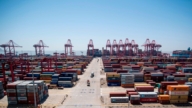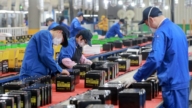【新唐人2012年7月16日讯】中国经济增长减缓成为国际舆论焦点。中国今年第二季度GDP三年来首次“破八”。大陆有大学教授大声疾呼“18大后能否启动真正的改革,是经济发展关键”,学者呼吁大陆经济迈向真正的“市场机制”。也有学者指出,中国过去二十年的高速增长依赖的“低成本模式”已经结束,中国经济进入了大拐点。
中国的第二季度GDP增长率官方公布为7.6,这是三年来首次低于百分之八的数字。著有《大拐点》等著作的经济评论家袁剑指出,他对“破八”毫不感到意外。他说,货币政策恢复正常以后,中国的经济增长速度一定是一个下降的过程。
袁剑:“09年以后,基本上是刺激政策,信贷泡沫导致的,重新出现的所谓高速增长。本来中国潜在增长率在2007年已经在下降了。国际形势,包括中国内需增长,到07年都有问题了。08年有一个刺激政策,把它带动了两三年。现在货币恢复正常,下降基本是非常正常。”
美国《外交政策》(Foreign Policy)杂志发表《中国经济灾难的五个迹象》文章。文章中指出,各种数据显示,中国广为传颂的经济增长引擎已经熄火,包括企业借款减少;制造业产出下降;利率意外削减;进口增长停滞;GDP增速预期已经下调。
袁剑则指出,中国经济高速增长依赖的“低成本模式”已经终结,这意味着中国经济高速列车必然刹车。所谓“低成本模式”就是剥削廉价劳动力,剥夺公民社会福利,并破坏环境,贻害子孙后代的方式,换取暂时的高速经济增长。
袁剑:“中国政府参与经济活动非常多,非常广泛和深刻的卷入了经济增长的过程。政府在这当中起到的作用其实就是压低成本的作用。压低各种各样的成本,环境成本,劳动力成本,甚至免费送地,这样的情况压低了中国制造业的成本,这些成本不会无缘无故的消失,他被转移了。”
但是社会在觉醒,每年数万起“群体事件”就是对这种低成本模式的反弹,中国高速经济增长也走向终结。
“复旦大学”财务金融系教授孔爱国对《中央社》表示,中国经济问题的根源乃是政治体制。他说,“政治格局决定政府行为,政府行为不改变,真正的市场经济机制难启动。”他认为,央企、国企一定要改革,分散股权走向民营化,“不能什么重大建设都独厚央企、国企”,政府不退出来,央企、国企就不会退,民间力量进不来,资金无处投放,大陆经济会变成一潭死水、恶性循环。
“中国清华大学”经济管理学院教授魏杰表示,中国必须立足于经济增速不能掉到7%以下,否则会引发失业等“社会深层次问题”。袁剑认为,经济放缓本身是一个正常现象。中国的问题在于,社会建设,福利制度等社会基础的薄弱,和政治制度的薄弱所导致的社会承受能力脆弱。他说,经济放缓可能出现各种各样难以预料的后果。
总部位于伦敦的研究公司“凯投宏观”(Capital Economics)在上次经济低迷(也就是2008年和2009年全球金融危机)期间,创建了自己的中国GDP指数。这个指数显示,中国经济今年第一季度的增速在7.6%左右,比官方的GDP数据低0.5个百分点。可以推测,第二季度百分之7.6的GDP数字也是含有水分的。
采访/编辑/秦雪 后制/钟元
China’s GDP growth falls below 8%, indicating the end of
“cost reduction mode” in stimulating the economy
Recently, China’s GDP growth slow down became the central
topic of global media.
In the second quarter of 2012, China’s GDP growth fell
below 8% for the first time in three years.
Some mainland professors claimed that the key for keeping
economic development depends on whether the 18th national congress initializes a true reform.
Some scholars also called for turning China’s economic
system into a real market one.
Another scholar pointed out that, China’s “cost reduction
mode” which generated the high GDP growth in the past 20 years had reached its end;
China’s economy has encountered a big turning point.
The CCP authority announced officially that China’s GDP
growth in the second season of 2012 is 7.6%,
which for the first time fell below 8% in three years.
Yuan Jian economic commentator and the author of “A Big
Turning Point” said that this was nothing surprising.
Yuan remarked that, as the monetary policy restored to
normal China’s economic growth would inevitably drop.
Yuan Jian: ”After 2009, the high economic growth was basically
induced by stimulation policies and bubble economy from loans.
In fact China’s potential economic growth had been
dropping since 2007.
At that time, the global situation and low domestic demand
caused trouble to China’s economy.
In 2008 the authority introduced a stimulation policy
and it worked for two to three years.
Currently as the monetary policy is restored, the GDP growth
Slow down can be expected.”
US magazine Foreign Policy published an article called
“Five signs of the coming economic disaster in China”.
The article said that, according to the statistics, burnout
of China’s well-praised economic growth engine had occurred.
The signs included loan reduction from companies, decreasing
output of manufacturing industry,
unexpected cut of interest rates, cease of export growth and
drop of expected GDP growth.
Yuan Jian pointed out that the “cost reduction mode”
which China relied on to keep a high economic growth,
has reached its end; hence the “high-speed train” of
China’s economy had to decelerate.
The so-called “cost reduction mode” refers to generating a
temporary economic growth by exploiting labor costs,
depriving civilians of their social benefits and
destroying the environment.
Yuan Jian: “Involved in numerous economic activities,
the Chinese Communist Party (CCP) government had
a wide and huge effect on the process of economic growth.
In fact the CCP played a role of reducing various kinds of costs
such as environmental cost, labor cost and giving out free land.
These moves reduced the cost of manufacturing industry
in China.
However, the reduced cost did not disappear;
they were only shifted.”
However, Chinese civilians are gradually awakening.
They reacted to the “cost reduction mode” with massive
protests which happened tens of thousands times a year,
bringing an end to China’s high GDP growth.
Professor of Finance Department at Fudan University,
Kong Aiguo told the Central News Agency that
the problems of China’s economy were rooted in
the political regime.
Kong said, “Governmental behavior is determined
by its political system.
Without changing governmental behaviors,
it’s impossible to develop a true market economy”.
Kong believes that the state-owned companies must
reform and transfer equities to civilians.
“We can’t only give benefit to state-owned companies
in every important project” Kong said.
“Civil investments are all blocked with state-owned
companies staying in the way.
China’s economy will be trapped into a vicious cycle
towards a stagnant form.”
Professor of Economic College at Tshinghua University
Wei Jie once claimed that
China’s GDP growth could not fall below 7%,
otherwise many fundamental social problems
such as unemployment growth would be induced.
Yuan Jian remarked that GDP growth slowdown was
a natural phenomenon itself.
The real problem lay in malfunctions of social construction,
welfare and other fundamental systems.
China’s frail political regime also led to a low endurance
capacity of the whole Chinese society.
Yuan believes that GDP growth slow down might result
in various unexpected problems.
UK-based company Capital Economics created
its own index of China GDP between 2008 and 2009.
According to the index, China’s economy increased by 7.6%
in the first season of 2012, 0.5% lower than CCP official data.
It is expected that the officially announced 7.6% GDP
growth in the second season is also an exaggerated number.



























